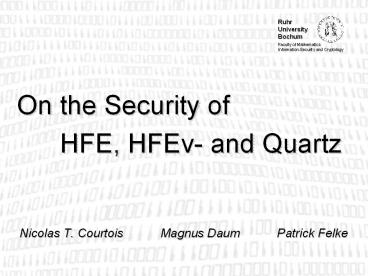On the Security of HFE, HFEv- and Quartz PowerPoint PPT Presentation
1 / 27
Title: On the Security of HFE, HFEv- and Quartz
1
On the Security of HFE, HFEv- and Quartz
- Nicolas T. Courtois Magnus Daum Patrick Felke
2
Overview
- HFE Hidden Field Equations
- Solving HFE systems with Gröbner Bases
Algorithms - Simulations
- Conclusion
- Basic HFE
- Signing/Verifying with HFE
- Perturbations
- Parameters
3
HFEHidden Field Equations
4
Basic HFE
one-way trapdoor function
Trapdoor
5
Basic HFE Example
6
Basic HFE Example
7
Basic HFE Example
Verifying
P(S) M ?
8
Basic HFE Example
Signing
9
Perturbations
10
Perturbations
- Little changes on the multivariate side of the
cryptosystem which are used to hide the
underlying algebraic structure - e.g. - (i.e. removing polynomials)
Public Key
11
Perturbations
- Little changes on the multivariate side of the
cryptosystem which are used to hide the
underlying algebraic structure - e.g. v (i.e. adding variables)
Public Key
(after mixing with S and T)
12
Perturbations
- Other perturbations
- Adding random polynomials ()
- Fixing some variables (f )
- Perturbations can be combined (e.g. to HFEv-
systems) - Perturbated systems are claimed to be more secure
- Quartz, Flash, SFlash are all perturbated HFE
systems
13
Parameters
perturbations and secret key
- q size of smaller finite field K
- h extension degree of L (i.e. Lqh)
- d degree of hidden polynomial ?
- number of added/removed
polynomials/unknowns
14
Overview
- General Approach with Buchberger Algorithm
- Characteristics of HFE systems
- Faugères Attack on HFE Challenge 1
- What is HFE?
- Solving HFE systems with Gröbner Bases
Algorithms - Simulations
- Conclusion
15
General Approach Example
Signing
16
General Approach Example
17
General Approach
- exponential worst case complexity in general
- ) only feasible for very few unknowns
- HFE systems are special
- very small finite field
- quadratic polynomials
- solutions in the base field Fq
18
General Approach Example
- Advantages
- we compute only information we need
- degree of polynomials involved in this
computation is bounded
19
General Approach
- exponential worst case complexity in general
- ) only feasible for very few unknowns
- But HFE systems are special
- ! Optimized variants of Buchberger algorithm
might be able to solve Basic HFE systems
- very small finite field
- quadratic polynomials
- solutions in the base field Fq
- hidden polynomial
20
General Approach
- Best known Attack on Basic HFE
- Faugères Algorithm F5/2 (April 2002)
- succesfully attacked HFE challenge 1 (h80,
d96) in 96h on 833 MHz Alpha workstation - On perturbated HFE systems
- No feasible attacks known yet
- Algorithms like F5/2 can be applied to such
systems - Complexity is not known
21
Overview
- What to measure?
- Special Case of Signing
- Results
- What is HFE?
- Solving HFE systems with Gröbner Bases
Algorithms - Simulations
- Conclusion
22
Simulations
- in SINGULAR using the stdfglm function
- Parameters
- finite field K F2
- h 2 15,19,21
- HFE systems with d 2 5,9,17 and randomly
generated quadratic systems
- Signing
- Perturbations v and -( removed 0 to 3
polynomials and and added 0 to 5
unknowns)
23
What to measure?
- How well can the trapdoor be hidden by applying
perturbations? - How much can perturbations ensure that an HFE
system with a trapdoor seems to be a random
system (without a trapdoor)? - 0 R 1
- Randomness Security
24
Special Case of Signing
- Each solution of a given HFE system is a valid
signature - ! it suffices to find one solution
- Gröbner bases algorithms give all solutions at
the same time - Complexity seems to grow with increasing number
of solutions - - and v increase number of solutions
25
Special Case of Signing
- ! decrease number of solutions
- Fix some variables, such that the expected number
of solutions of the system is 1 - Try to solve the resulting system
- If it was not solvable, repeat this until a
solution is found
26
Experimental Results
h15, d5, q2
27
Experimental Results
- R depends mainly on the total number vr of
applied perturbations - - may even decrease the total time
- ! use more v
- d very small, i.e. Rltlt1vr perturbations make
the complexity increase by a factor of about qvr - The smaller R is, the stronger is the effect of
the perturbations
28
Conclusion
- HFE can be attacked with Gröbner bases algorithms
- Complexity is very high
- and can be increased by applying perturbations
- In Quartz better take d257 (instead of 129) but
that slows down Quartz
29
Thank you!Questions ?

